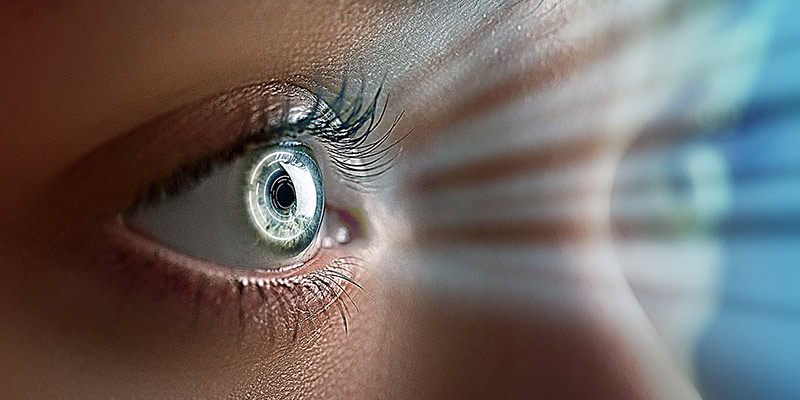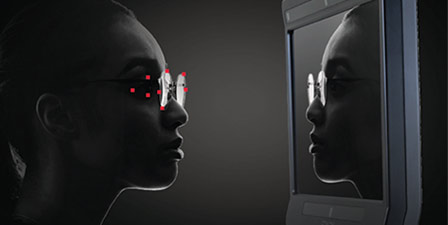
By Linda Conlin, Pro to Pro Managing Editor

Conventional wisdom was that people with dry eye disease (DED) couldn’t wear contact lenses, but recent innovations have changed that. New lens materials and surface treatments have resulted in greater comfort and longer wearing times for DED sufferers. Now, contact lenses have gone even further with lenses that release drugs to treat DED.
Medicating the ocular surface is traditionally achieved through administration of eye drops. Unfortunately, frequent dosing is inconvenient, not cost-effective and often leads to patient non-compliance. However, drug-eluting contact lenses can be used for the prolonged release of medication onto the ocular surface. One substance used to treat DED is hyaluronic acid (HA), found naturally in the tear film and a key component in many artificial tears. HA is biocompatible and effective at retaining moisture on contact lenses. The lenses can be soaked in a solution of HA, or it can be incorporated into the lenses for continuous release, which not only aids the treatment of dry eye but also serves as a wetting or comfort agent. (Chang WH, Liu PY, Lin MH, Lu CJ, Chou HY, Nian CY, Jiang YT, Hsu YH. It Applications of Hyaluronic Acid in Ophthalmology and Contact Lenses. Molecules. 2021 Apr 24;26(9):2485. doi: 10.3390/molecules26092485. PMID: 33923222; PMCID: PMC8123179)
Cyclosporine is another drug used to increase tear production in DED patients. When cyclosporine was incorporated into a contact lens and tested on rabbits, the medication was slow released over 120 hours. This resulted in reduced ocular surface inflammation, which can improve tear volume, tear break up time and reduce corneal staining. (Role of micelle dynamics in enhancing cyclosporine uptake in hyaluronic acid-contact lenses, doi.org/10.1016/j.colsurfa.2024.133550; sciencedirect.com/science/article/pii/S0927775724004114)
Tip: Drug-eluting contact lenses can provide continued medication release, protect the cornea and promote epithelial healing in DED.
The incidence of myopia is increasing at an alarming rate, and eyecare professionals have used two types of contact lenses to slow its progression in children. One is overnight orthokeratology (OrthoK), the temporary reshaping of the cornea with specially made rigid contact lenses. Flattening the cornea shortens the distance to the retina, so light focuses properly. At the same time, peripheral images that focus behind the retina are brought forward. Orthokeratology has the added benefit of freeing the patient from using correction during the daytime. It allows for more parental control and is a great option for athletes, especially swimmers. Current research shows promising signs that ortho-k lenses can be modified to increase the myopia control effect.
Another type of contact lens for myopia management is soft multifocal and dual-focus contact lenses, collectively referred to as peripheral defocus contact lenses (PDCL). PDCL designs include simultaneous vision soft lenses, such as aspheric progressive, dual-focus, traditional multifocal, ring focus and extended depth of focus designs. Each design utilizes different zones of power within the lens to focus peripheral light rays in front of the retina to act as a stop signal for myopia progression while also optimizing vision correction.
Tip: Randomized controlled trials have demonstrated that both OrthoK and PDCLs effectively slow myopia progression in children. Become familiar with the various lens designs and the basis for the doctor’s lens choice for each patient.
Contact lenses continue to expand in functionality and application. One “smart” lens prototype is designed to offer a non-surgical solution for patients suffering from keratoconus, corneal irregularities, photophobia and presbyopia. It will adjust the brightness of incoming light automatically based on a user’s needs while functioning as a traditional lens to minimize light sensitivity and increase visual acuity.
Smart contact lenses also can function as noninvasive diagnostic and therapeutic wearables that address several ocular diseases, as well as some systemic conditions. UAE researchers recognized the importance of UV protection in contact lenses, but also the significance that ocular surface temperature has for conditions such as dry eye, glaucoma and diabetic retinopathy, as an indicator of inflammation. They combined the two functions in a multifunctional transition and temperature-sensitive contact lens. When activated by UV exposure, the lenses darken and, as temperature-responsive contact lenses, they exhibit distinct color variations according to temperature changes. Since these multifunctional lenses showed good UV and blue light filtering capabilities along with physiological temperature-responsiveness, they potentially can be utilized as therapeutic and diagnostic wearable aids to monitor and prevent various ocular diseases.
There are smart contact lenses capable of displaying visible information on the cornea and can be used to access augmented reality. But the lenses need to be powered by rechargeable batteries that rely on wires or induction coils containing metal, presenting risks to the wearer. Now, scientists in Singapore have developed a thin, flexible battery that stores electricity when immersed in saline solution and can be embedded in a lens, that could power smart contact lenses. The battery also could be powered by human tears, which are similar in composition to the saline solution.
Tip: New developments are expanding the function of contact lenses beyond vision correction to devices that monitor eye and systemic health and provide therapeutic functions. Be ready to put them into practice!












